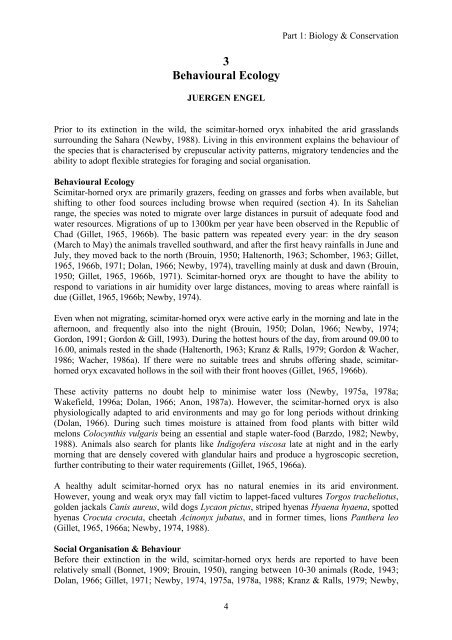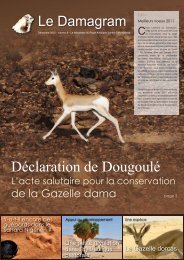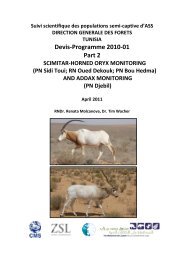The Biology, Husbandry and Conservation Scimitar-horned Oryx ...
The Biology, Husbandry and Conservation Scimitar-horned Oryx ...
The Biology, Husbandry and Conservation Scimitar-horned Oryx ...
Create successful ePaper yourself
Turn your PDF publications into a flip-book with our unique Google optimized e-Paper software.
3<br />
Behavioural Ecology<br />
JUERGEN ENGEL<br />
4<br />
Part 1: <strong>Biology</strong> & <strong>Conservation</strong><br />
Prior to its extinction in the wild, the scimitar-<strong>horned</strong> oryx inhabited the arid grassl<strong>and</strong>s<br />
surrounding the Sahara (Newby, 1988). Living in this environment explains the behaviour of<br />
the species that is characterised by crepuscular activity patterns, migratory tendencies <strong>and</strong> the<br />
ability to adopt flexible strategies for foraging <strong>and</strong> social organisation.<br />
Behavioural Ecology<br />
<strong>Scimitar</strong>-<strong>horned</strong> oryx are primarily grazers, feeding on grasses <strong>and</strong> forbs when available, but<br />
shifting to other food sources including browse when required (section 4). In its Sahelian<br />
range, the species was noted to migrate over large distances in pursuit of adequate food <strong>and</strong><br />
water resources. Migrations of up to 1300km per year have been observed in the Republic of<br />
Chad (Gillet, 1965, 1966b). <strong>The</strong> basic pattern was repeated every year: in the dry season<br />
(March to May) the animals travelled southward, <strong>and</strong> after the first heavy rainfalls in June <strong>and</strong><br />
July, they moved back to the north (Brouin, 1950; Haltenorth, 1963; Schomber, 1963; Gillet,<br />
1965, 1966b, 1971; Dolan, 1966; Newby, 1974), travelling mainly at dusk <strong>and</strong> dawn (Brouin,<br />
1950; Gillet, 1965, 1966b, 1971). <strong>Scimitar</strong>-<strong>horned</strong> oryx are thought to have the ability to<br />
respond to variations in air humidity over large distances, moving to areas where rainfall is<br />
due (Gillet, 1965, 1966b; Newby, 1974).<br />
Even when not migrating, scimitar-<strong>horned</strong> oryx were active early in the morning <strong>and</strong> late in the<br />
afternoon, <strong>and</strong> frequently also into the night (Brouin, 1950; Dolan, 1966; Newby, 1974;<br />
Gordon, 1991; Gordon & Gill, 1993). During the hottest hours of the day, from around 09.00 to<br />
16.00, animals rested in the shade (Haltenorth, 1963; Kranz & Ralls, 1979; Gordon & Wacher,<br />
1986; Wacher, 1986a). If there were no suitable trees <strong>and</strong> shrubs offering shade, scimitar<strong>horned</strong><br />
oryx excavated hollows in the soil with their front hooves (Gillet, 1965, 1966b).<br />
<strong>The</strong>se activity patterns no doubt help to minimise water loss (Newby, 1975a, 1978a;<br />
Wakefield, 1996a; Dolan, 1966; Anon, 1987a). However, the scimitar-<strong>horned</strong> oryx is also<br />
physiologically adapted to arid environments <strong>and</strong> may go for long periods without drinking<br />
(Dolan, 1966). During such times moisture is attained from food plants with bitter wild<br />
melons Colocynthis vulgaris being an essential <strong>and</strong> staple water-food (Barzdo, 1982; Newby,<br />
1988). Animals also search for plants like Indigofera viscosa late at night <strong>and</strong> in the early<br />
morning that are densely covered with gl<strong>and</strong>ular hairs <strong>and</strong> produce a hygroscopic secretion,<br />
further contributing to their water requirements (Gillet, 1965, 1966a).<br />
A healthy adult scimitar-<strong>horned</strong> oryx has no natural enemies in its arid environment.<br />
However, young <strong>and</strong> weak oryx may fall victim to lappet-faced vultures Torgos tracheliotus,<br />
golden jackals Canis aureus, wild dogs Lycaon pictus, striped hyenas Hyaena hyaena, spotted<br />
hyenas Crocuta crocuta, cheetah Acinonyx jubatus, <strong>and</strong> in former times, lions Panthera leo<br />
(Gillet, 1965, 1966a; Newby, 1974, 1988).<br />
Social Organisation & Behaviour<br />
Before their extinction in the wild, scimitar-<strong>horned</strong> oryx herds are reported to have been<br />
relatively small (Bonnet, 1909; Brouin, 1950), ranging between 10-30 animals (Rode, 1943;<br />
Dolan, 1966; Gillet, 1971; Newby, 1974, 1975a, 1978a, 1988; Kranz & Ralls, 1979; Newby,





